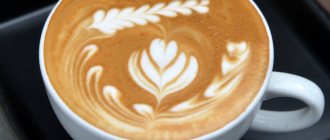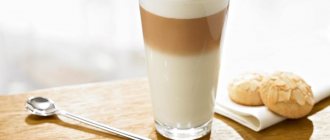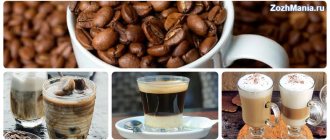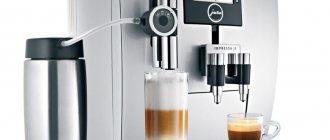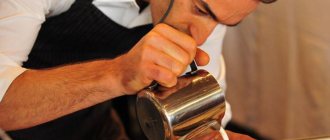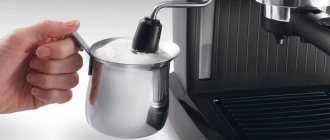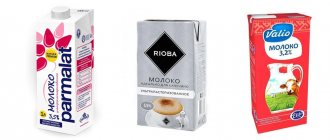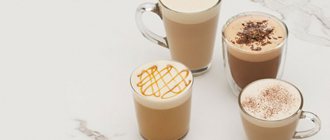Caffe latte is a drink based on whipped milk and coffee, with a predominance of milk. Latte has gained great popularity in Europe and America due to its mild taste and beautiful presentation. How to prepare and serve a latte correctly, how to find out the calorie content of a serving and which syllable to emphasize in the name of the drink? We'll tell you everything you need to know about lattes and a little more.
Caffe latte: what is it?
Is a latte coffee with milk or milk with coffee? In our opinion, the last statement is more true. And the name of the recipe itself confirms its attraction to the dairy component. “Latte” translated from Italian means “milk”.
- Who and when first made latte coffee is still unknown. Italians attribute the authorship to themselves, rightly emphasizing that the name is Italian. The French claim that they themselves are quite capable of preparing cafe au lait. The Austrians recall that they were the first to mix coffee with milk on the territory of the Austrian Empire.
- There is a popular story in Italy that latte was originally just warmed milk. But one barista decided to add some coffee as a flavoring. This is how the latte coffee recipe came about.
- Whoever came up with the recipe still owes its existence today to Italian baristas. It was through their efforts that the existing classic proportions of latte coffee were established, the basic standards of preparation were established, and the menu of coffee shops around the world adorned the name “Latte”.
Recipes for making latte coffee at home
Many latte lovers think that making it is a rather complicated and time-consuming process. In fact, you shouldn't be upset in the first place. There are tricks you can use to make an amazing latte at home. The main thing in this matter is to adhere to some recommendations:
- To brew coffee in the absence of a coffee machine, use any convenient methods.
- It is important to use strong coffee. Lattes are best made from brewed coffee.
- The milk must be heated, but not boiled; it is whipped into foam.
- Initially, you need to prepare a glass and pour milk into it, its foam will form on top.
- Then coffee is poured into the milk. It is necessary to add extremely carefully, pouring in the coffee in a thin stream.
- The top of the foam is decorated with chocolate.
There are many recipes for making this drink. Each of them is interesting in its own way.
Composition and proportions of latte
The recipe contains only two ingredients - espresso coffee and frothed milk. Sugar and sprinkles are added as desired.
The soft, creamy taste of the drink and its elegant appearance are ensured by the preparation technology and the proportions of the ingredients. To make a latte, you need one part espresso, two parts milk and one part milk foam. For a classic latte recipe, 200 ml in volume, you will need:
- 50 ml espresso
- 150 ml milk
- 50 ml foam
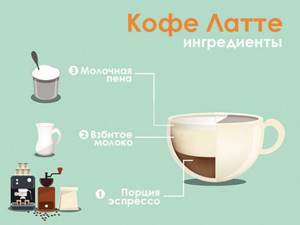
However, in modern coffee shops there is a tendency to increase portions. The latte grows in volume to 300-400 ml. One would expect a simple increase in the serving size while maintaining the proportions, but in reality the serving of milk increases, and the coffee remains almost the same amount.
Classic latte and with additives, recipes
The simplest is the traditional option: black coffee and milk whipped into thick foam.
Ice latte
From the name itself it is clear that this is a summer option. It is better to use a shaker one-quarter filled with ice. Freshly brewed espresso, milk and topping (syrup) are poured into a shaker and shaken until the ice dissolves. Add 20 ml of syrup to 150 ml of milk.
Coffee with ice cream
This recipe also applies to summer. In a Turk or coffee maker, brew coffee at the rate of one tablespoon of ground beans and 60 ml of water. You will also need 150 ml of milk. Pour coffee into the prepared cup and combine with whipped milk. The final touch is a scoop of ice cream (creme brulee or classic ice cream) decorated with chocolate decor.
Latte coffee recipe
How to make a latte? The recipe, although simple, requires some skill.
First, prepare a 35-50 ml portion of espresso.
Then take milk for whipping. If you do not carefully monitor your calorie consumption, then take a product with a fat content of 3.5%. With it, coffee will have a silky and delicate taste. Skim milk makes lattes watery. The volume of milk should be 200 ml for the classic recipe, as part of the product will turn into that delicious foam for which we love lattes.
Some gourmets and gourmands really appreciate the delicate, sweetish taste of latte, made from a mixture of cream and milk in proportions of 1/1. Mix the cream and milk before whipping.
Whisk the milk until a coarse foam appears. For a latte, the foam should be loose, oxygenated, and bubbly. It is important not to beat the foam, otherwise it will become too dense.
Pour milk and foam into a tall cup or latte glass. Then carefully, in a thin stream, pour in the finished coffee along the wall. As a result, the foam cap remains on top, and the coffee is mixed with liquid milk. The drink is ready, you can serve it.
More recently, baristas have gone to great lengths to ensure that lattes maintain their flaky texture. Of course, visitors liked the alternation of milk and coffee so much! But windy fashion has changed the requirements. Nowadays the trend is democratic simplicity and emphasized minimalism, without excessive decoration. Therefore, today's fashionable latte has a homogeneous structure, to obtain which the drink can be stirred.
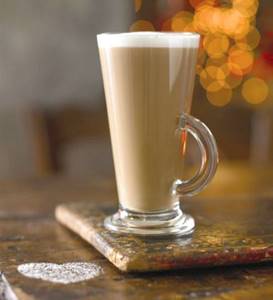
Latte
This method of amusing yourself with a cup or two of tasty drink came to us from Italy, in general, like a huge number of other, more pleasant methods. What a coffee latte is, the translation of the word from Italian will give you a hint, and it means coffee with milk.
We recommend reading a fascinating article on our website: What exactly is espresso coffee?
If you look at a cross-section of a glass of latte, you can see that its contents consist of 3 unequal parts: the bottom is espresso, the middle is milk, the top is the most delicate milk foam. To achieve masterful stratification of the product, you must have special practical skills. This task is best handled by professional people - baristas, coffee sommeliers.
Composition of the drink
We have already mentioned what the observed magic consists of. But this is not just brewed Arabica with the addition of a dairy component, but a dish prepared according to special nuances and recipes.
What is the composition of the latte? In coffee shops it is prepared from espresso and milk in a ratio of one to three. Espresso is obtained using a coffee machine, and the top foam is obtained using a fascinating technical device called a coffee machine cappuccino maker and a pitcher - a special stainless steel mug with heated milk poured into it in advance. Then the milk is carefully poured into the glass, along the side, so that it mixes smoothly with the coffee.
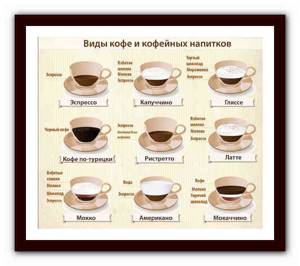
What is the composition of coffee latte? In coffee shops it is prepared from espresso and milk in a ratio of one to three.
It is not customary for Italians to add sweet sand to this drink. If the delicacy seems bland, then make do with a small addition of syrup. In addition, you can add cocoa, chocolate, vanilla, and liqueur to your drink. Experts do not recommend using citrus syrups, as they can seriously spoil the milky taste.
Coffee calories
The calorie content of a drink is determined by its ingredients. For example, the energy value of a traditional latte is 175 Kcal per 100 g of the main component. But a syrup or chocolate latte will surpass all the nutritional characteristics of the classic.
Coffee latte recipe at home
For a quick latte, it's best to have an automatic coffee maker on hand. If you are planning to treat yourself to a delicate drink, but have not yet acquired a coffee machine, then especially for you we will tell you how to make latte coffee at home.
What will you need?
- Strong coffee brewed in a cezve, geyser coffee maker, or even infused in a French press. Proportions – 2 heaped teaspoons per 80 ml of water. After preparation, be sure to strain so as not to spoil the pampered structure of the future drink.
- Milk for whipping. At home, you will have to beat with a whisk, blender or mixer; to obtain foam you will need a product with a fat content of at least 3.2%. Otherwise you won't get good foam. If you are not afraid of extra calories, but are afraid of unstable foam, then feel free to take a mixture of cream and milk in proportions 1:1. In total you need 200 ml of milk or creamy milk mixture.
- Sugar and other sweet bonuses - to taste.
How to cook?
- First, prepare and filter the coffee, measure out 50 ml. We set it aside.
- Lightly heat the prepared milk in the microwave, to approximately 30-40 degrees.
- Beat the heated milk at high speed for 3-4 minutes. A signal that you have achieved your goal will be the formation of airy, porous foam on the surface of the milk.
- Heat a tall cup or glass goblet in the microwave.
- Pour milk with foam into a cup.
- Carefully pour in the coffee, you can use a knife blade.
- Spread the remaining foam onto the surface of the drink using a spoon.
- Your homemade latte is ready.
The quality and taste of the latte depends on the quality of the milk and whipped foam; there is little coffee in the recipe, so its bouquet is weak. If we talk about the most suitable coffee for latte, then it is best to use soft Arabica varieties or a mixture with a minimum content of Robusta.
How to make a latte at home without a coffee machine
Many coffee drink lovers believe that a drink with several layers is called a latte. But in reality, it's a macchiato. Whereas a latte is coffee mixed with milk and covered with milk foam.
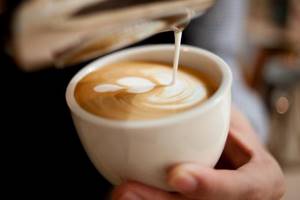
You can master the preparation of such a treat without a coffee machine.
- First, you should prepare espresso. It is better to brew latte coffee in a Turkish coffee pot, but in extreme cases, you can also use instant powder. The main thing is to remember the proportions of coffee and milk - 1:3. One serving will require about 50 g of drink.
- Heat the milk to a temperature of 60 degrees, but under no circumstances bring it to a boil. Using an immersion blender, beat the milk for 3-4 minutes. Perhaps in an aluminum container the foam will be more abundant and the process will not require as much time.
- Pour espresso into a prepared tall glass and add milk.
- Place milk foam on top with a spoon.
- But for macchiato, the layers should not be mixed. It is important to carefully fill the glass.
- Additionally, you can decorate the foam by sprinkling with chocolate chips or adding cinnamon.
Enjoy a truly divine treat.
Latte coffee calories
The nutritional value of a coffee latte directly depends on the amount of milk used for preparation, its fat content and sweet additives in the recipe - sugar, sprinkles, topping.
- A 250 ml serving of latte, prepared using milk with a fat content of 2.5%, has a calorie value of 109-110 kcal.
- The same serving with 3.2% fat milk contains 116-118 kcal.
- Each teaspoon of sugar added to a latte increases calories by 20 kcal.
- A latte made from a mixture of 10% cream and milk with a fat content of 2.5% has a calorie content of 175 kcal, and with two tablespoons of sugar the nutritional value of the drink will increase to 215 kcal.
For latte coffee, the portion of which exceeds the classic 250 ml, the calorie content increases in proportion to the increase in the amount of milk.
Serving rules: glasses and cups for latte
The popularity of the latte recipe prompted glassware manufacturers to come up with special glasses and cups for this recipe.
- Latte glasses are made of transparent glass, have a cone shape and a thickened bottom. A few years ago they came with a handle and stand. Unlike Irish glasses, latte glasses did not have a leg; the stand was attached directly to the bottom. Today's trend towards minimalism and laconic forms has given rise to a new generation of latte glasses. They look like ordinary tall glasses in the shape of a truncated inverted cone. Perhaps the thickness of the glass and the impressive bottom indicate that hot drinks are drunk from these glasses.
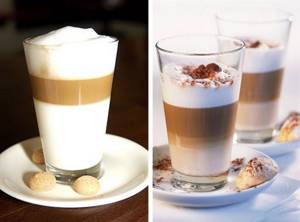
- After the trend for “striped” lattes passed, coffee began to be served not only in glass glasses, but also in cups. It is believed that latte cups do not look as formal and formal as glass glasses. Cone-shaped latte cups have an impressive volume of up to 400 ml. They can be equipped with a handle or silicone holders that are located along the diameter of the cup.
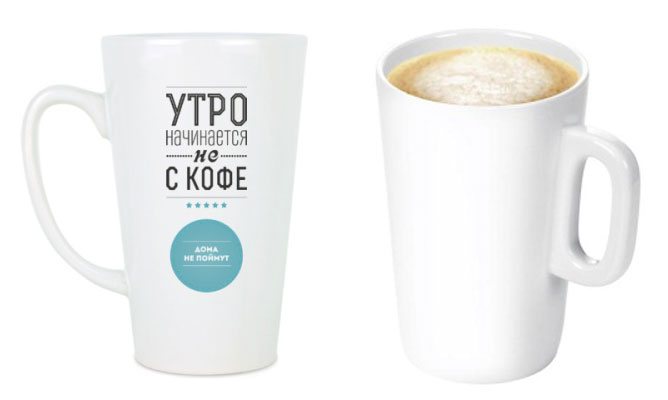
Long-handled spoons for stirring the drink are often sold along with latte cups. The large volume of dishes does not allow the use of ordinary teaspoons.
Serve the latte hot, without waiting for it to cool. Cups are placed not on saucers, but on special coasters.
What is the difference between a latte and a cappuccino?
This question often occupies fans. The ingredients of the drinks are the same - coffee and milk, optionally sugar. So, maybe this really is the same coffee, just under different names?
We hasten to disappoint fans of simplifications - latte and cappuccino are different drinks. We have already talked in detail about their main differences in one of the previous articles, so we will only note the key points on which the recipes differ.
- Proportions . A cappuccino is made from one part coffee and two parts milk, and a latte is made from one part coffee and four parts milk. Therefore, latte has a much higher milk content.
- Cooking method . To prepare a cappuccino, milk is poured into the prepared coffee, while for a latte, on the contrary, coffee is poured into frothed milk.
- Foam quality . Lattes are decorated with loose, porous foam. For cappuccino, whip up a denser, silkier, uniform foam with fine bubbles. To obtain such foam, the milk needs to be whipped longer than for a loose “cap” of a latte.
- Caffeine content per 100 ml . For cappuccino, take more coffee, up to 100 ml per 200 ml of milk. For latte, a portion of 50 and sometimes 30 ml is prepared. Therefore, a latte is much less strong than a cappuccino.
So, a cappuccino contains more espresso than a latte, it is stronger and its taste is more expressive. The cappuccino foam is denser and smoother. Latte contains less espresso, its taste is milky, delicate, sweetish, silky, and the foam is loose and airy.

Differences between latte and cappuccino
In the modern world, it is difficult to find a person who has never tried a latte or cappuccino in his entire life. However, not everyone knows the difference between them. Also, many people make a mistake in the word “cappuccino”, believing that it contains double letters. At the same time, in the word “latte” the stress always remains on the first syllable.
The main difference between a cappuccino and a latte is, first of all, that the latter is not coffee. In fact, a latte is just a coffee drink; sometimes it is also called a cocktail. It may follow from this that the volume of coffee in a cappuccino is much larger than the entire drink. If you rely on the classic latte recipe that we described above, two servings of milk are required per serving of espresso (milk foam can also be used). For cappuccino, each ingredient has the same proportions.

Proportions of milk and espresso in cappuccino and latte.
Even their foams are different. Of course, milk foam in any case should have a uniform consistency and no air bubbles. But the significant difference is that thicker foam is used for cappuccino. When the foam does not fall off when sugar gets on it, this means that the drink is prepared correctly.
However, both drinks still have similarities. Namely, the method of their preparation. First, a portion of coffee is poured, then milk is added. It must first be heated to a certain temperature. Usually it is about sixty degrees.
The serving method also differs for each type of coffee. For cappuccino, cups of 180 milliliters are usually used, no more. With this volume you get a better balance between milk and espresso. To ensure that there is enough milk for the entire coffee, it is better to use cups with an expanded top.
For both latte and cappuccino, the same temperature is acceptable, no higher than seventy degrees. By adding frothed milk to the drink, you can use it to create various patterns on the surface. There is a special technique called latte art.
In conclusion, we can conclude that the similarities between the two types are only in the method of preparation. Everything else is completely different.
(2 likes)
Ukrainian Coffee Festival
Previous post
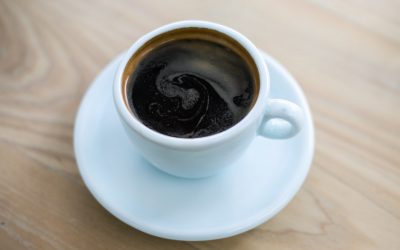
Americano
Next entry
How to drink latte correctly
Latte drinking habits have changed over the past few years.
Previously, lattes were served in glass glasses with a straw through which you had to drink coffee. The style of serving and drinking lattes was more reminiscent of cocktails in bars.
Now both serving and drinking lattes have become more democratic. The layered structure of the drink is no longer in fashion. Glass glasses with straws give way to tall cups with funny inscriptions. The straws have been replaced by spoons with a long handle, with which you can safely stir up your latte and drink coffee like a regular hot drink.
Timing your latte is important. According to Italians, this is a drink for the first half of the day. In the Apennines, coffee with milk is consumed until 11 o'clock. Drinking lattes and other milk-containing recipes later is thought to disrupt digestion. In any case, latte is never drunk after a meal, but only between meals. The only exception is breakfast, during which you can indulge in a cup of latte.
Instant coffee latte macchiato
Compound:
- instant coffee – 5 g;
- water – 50 ml;
- milk with fat content 3.2% – 150 ml;
- sugar – 15 g;
- ground cinnamon - a pinch.
Cooking method:
- Pour the milk into a small saucepan, mix it with sugar and place on low heat.
- Heat, stirring, until the sugar dissolves, but not less than 50 degrees. Do not let the milk boil.
- Remove the pan from the heat, beat the milk with a mixer until thick foam is obtained.
- Pour the milk into an Irish glass.
- Boil water and let it sit for a couple of minutes.
- Pour coffee into a cup, add water, stir.
- Pour coffee into a glass of milk. It should be hotter than milk. It is necessary to pour in a thin stream through the foam. If done correctly, the coffee will remain on top of the milk, but will sink underneath the foam.
All that remains is to sprinkle the cocktail with ground cinnamon and serve. A glass of coffee is placed on a saucer, after placing a napkin on it. Additionally, a long-handled spoon is provided, although stirring the latte before drinking is not recommended.
Latte art: how to apply?
Latte art is a technique for creating patterns on the surface of coffee using coffee and milk foam.
Latte art is much more common on cappuccino cups than on lattes. The dense foam of a cappuccino is better suited for drawing than the loose and airy surface of a latte. In addition, cappuccino is not stirred, unlike lattes.
If you are served a latte with drawn patterns, it means that you will drink the coffee through the foam without stirring. However, if you are determined to put sugar in your latte and stir the coffee, then you can safely do this by admiring the pattern on the surface. This will not be a violation of the rules.

